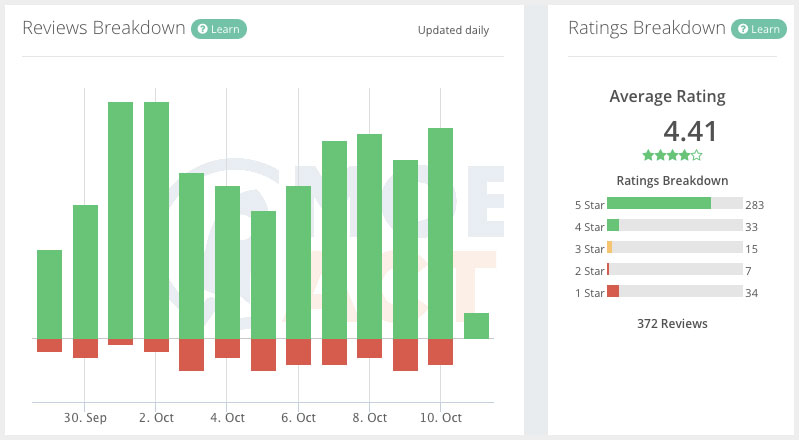Incipia blog
7 Steps to Research Other Mobile Apps for a Competitive Advantage
It’s said that preparation is the key to success. In all the excitement that comes with getting your new app out the door, don’t miss out on one of the keys success: competitive analysis.
Even if your app has been around for awhile, you still need to stay on top of what your competitors are doing, if you want to stay ahead.
You may know who your competitors are, but taking the time to actually research their marketing strategies, demographics, revenues, and more, will allow you to gain great insights that will ultimately result in more downloads.
Here are the seven steps to research a competing mobile app and improve your chances of success.
1. Begin by Tracking All Your Competitors
Competitive analysis starts with actually identifying your competitors. Discovering your competitors can be done by simple online research (AKA Googling), searching in the app store, asking your industry contacts, and so on.Once you have a running list of your competitors, it’s important to organize and track this information so no details fall through the cracks.
You may develop your own process using spreadsheets or some other tools, but regardless of what you use, always have a central place that you can track your competitors.
2. Discover Your Competitors’ Category Rankings and App Visibility Scores
Depending on how far along in their App Store Optimization (ASO) strategies your competitors are, their category rankings and app Visibility Scores may be formidable. But understanding where your app ranks in comparison, is the first step to figuring out how to beat them.
An app’s Visibility Score is a measurement of how easy it is to find in the app store’s search. Since a significant portion of your potential users are still using search to find new desirable apps, your Visibility Score is crucial. The easier it is to find yourapp, the more likely it is to be downloaded.
Category rankings, on the other hand, refer to discoverability within the specific category relevant to your app. While you may not be focused solely on rising in the category ranks, researching who’s at the top of your lists will shed light on who’s performing well.
Tracking your competitors’ app visibility scores and category rankings gives you a benchmark to aim for (and eventually surpass).
You’ll also be able to glean insight into how well your competitors are doing against each other. Note who’s beating who in terms of app Visibility Score and category ranking, especially across different stores, and analyze what strategies seem to be working well for them.
3. Get Their Estimated Downloads and Revenue
More metrics that matter include your competitors’ download volumes and revenues.Those category ratings mentioned above? They aren’t determined strictly by number of downloads. But that’s certainly a key factor in the ranking systems that the stores use.
Knowing the estimated number of downloads your competitors are getting will help you understand one aspect of how well your competitors are doing and where to set your sights.
Similarly, revenue numbers provide important data for goal-setting and decision-making, though you may have to rely on estimates for this highly competitive information.
4. Determine Your Competitors’ Keyword Strategies and Which Keywords are Working
The benefit of creating an effective keyword strategy for your mobile app can’t be overstated. But don’t do it with blinders on--you should also do some investigation of your competitors’ strategies.
Some keyword research platforms require a bit of guessing and checking, requiring you to research keywords individually. The Mobile Action platform takes it one step further.
You’ll be able to search for a competing app and then get an estimated percentage of organic downloads for each associated keyword, thereby showing you which keywords are actually working.
This can save you a ton of time.
Whatever method you use, you should come away with a solid list of keywords that are successful for your competitors, which you can then integrate into your own strategy.
5. Uncover Their Localization and Audience Demographics
App companies that do well globally don’t do so by accident. They have implemented a smart localization strategy that goes beyond Google Translate and actually incorporates keywords and other tactics that do well across different audiences.While marketing effectively to a diverse audience isn’t easy, examining how your competitors do it will give you some ideas to get started.
Here are some key performance indicators for apps that do well beyond their local market:
- Keywords: rather than simple word-for-word translations, keywords need to convey the same nuance and connotation across languages.
- Descriptions: like keywords, descriptions need to be carefully crafted so as to convey your desired meaning while still remaining in line with your strategy.
- Icon, images, and video: visual elements are significant to your audience, and should appeal to every segment of your target audience, not just your local market.
6. Mine Your Competitors’ Reviews for Insights

Reviews contain some of the most actionable information you can get from your competitors.
Most of us can agree that reviews are indicative of performance; if an app isn’t getting a large number of good reviews, it’s probably not a competitor to watch (for now). Examining the reviews of your big competitors will give you valuable insights into your potential audience’s experience and preferences.
First, reviews reveal keywords. Analyzing a competing app’s reviews and noting which words are used repeatedly will give you a solid list of keywords to that they may be ranking for, and that you may want to target.
With this tip more than any other on the list, you’ll also be able to tell where your competitors may be weak. By looking at the negative reviews, you may glean some points to use in your marketing strategy.
Is your competitor experiencing bugginess and you know your code is solid? Promote your stability.
In general, reading reviews of your most successful competitors will help you build a comprehensive understanding of what a good app looks like. It can also help you find new feature ideas.
7. Follow Your Competitors' Out-of-App-Store Marketing Efforts
Don’t forget to pay attention to what your competitors are doing outside of the app stores. This is a relatively simple exercise, and you may choose to keep a running spreadsheet or document to make sure you’re comprehensive.Doing some Google searches can help you uncover some paid strategies your competitors might be pursuing. What keywords are your competitors bidding on?
Inspect all their social media accounts. If there’s a specific platform that tends to get a lot of engagement, you might consider using that as well, as a strategy for gaining more brand recognition and ultimately app downloads.
Determine whether or not they have other community outreach tactics like Facebook groups, in-person events. Are there any strategies that you can emulate?
Conclusion
Don’t work on optimization in a vacuum. Competitive analysis doesn’t have to be complex, time-consuming, or costly, but it is an important part of your app development strategy.Also remember to split test everything you do. What may be working for other apps, might not work as well for your app.
Just use your research as a starting point.
 About the Author
About the Author
Rachel Wilson is a writer, marketer, and content creator for Mobile Action. She is currently living in NYC and has worked for technology companies like BetterCloud and Microsoft, and believes her English degree prepared her to write about pretty much anything. She misses the ocean and the mountains of the Pacific Northwest but can’t give up New York pizza.
Categories
Tags:
- A/B testing
- adjust
- advertising
- adwords
- agile
- analytics
- android development
- app analytics
- app annie
- app development
- app marketing
- app promotion
- app review
- app store
- app store algorithm update
- app store optimization
- app store search ads
- appboy
- apple
- apple search ads
- appsee
- appsflyer
- apptamin
- apptweak
- aso
- aso tools
- attribution
- client management
- coming soon
- design
- development
- facebook ads
- firebase
- google play
- google play algorithm update
- google play aso
- google play console
- google play optimization
- google play store
- google play store aso
- google play store optimization
- google uac
- google universal campaigns
- idfa
- ios
- ios 11
- ios 11 aso
- ios 14
- ios development
- iot
- itunes connect
- limit ad tracking
- ltv
- mobiel marketing
- mobile action
- mobile analytics
- mobile marketing
- monetization
- mvp
- play store
- promoted iap
- promoted in app purchases
- push notifications
- SDKs
- search ads
- SEO
- skadnetwork
- splitmetrics
- startups
- swift
- tiktok
- uac
- universal app campaigns
- universal campaigns
- user retention
- ux
- ux design